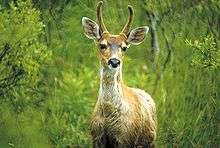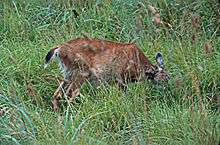Sitka deer
| Sitka deer | |
|---|---|
 | |
| Scientific classification | |
| Kingdom: | Animalia |
| Phylum: | Chordata |
| Clade: | Synapsida |
| Class: | Mammalia |
| Order: | Artiodactyla |
| Family: | Cervidae |
| Subfamily: | Capreolinae |
| Genus: | Odocoileus |
| Species: | O. hemionus |
| Subspecies: | O. h. sitkensis |
| Trinomial name | |
| Odocoileus hemionus sitkensis Merriam, 1898 | |
The Sitka deer or Sitka black-tailed deer (Odocoileus hemionus sitkensis), is a subspecies of mule deer (Odocoileus hemionus), similar to the Columbian black-tailed subspecies (O. h. colombianus). Their name originates from Sitka, Alaska, and it is not to be confused with the similarly named sika deer. Weighing in on average between 80 and 120 pounds (36 and 54 kg), Sitka deer are characteristically smaller than other subspecies of mule deer. Reddish-brown in the summer, their coats darken to a gray-brown in the winter. They are also good swimmers, and can occasionally be seen crossing deep channels between islands. Their average life span is about 10 years but a few are known to have attained an age of 15.[1]
Habitat and life patterns


Sitka deer inhabit the coastal rainforests of northern British Columbia, Canada and southeastern Alaska, United States. They have also been found on the islands of the Alexander Archipelago, Prince William Sound, Kodiak Archipelago, and Haida Gwaii[2] (Queen Charlotte Islands), British Columbia.
Sitka deer can be both migratory and residential depending on their habitat, but during winter months they primarily reside in old or mixed age forest growth below 1,500 feet (460 m).[3] The rut peaks in mid-November and fawns are born in the early June and weigh 6–8 pounds (2.7–3.6 kg). Bucks could weigh up to 120–200 pounds (54–91 kg) and does could weigh 80–100 pounds (36–45 kg).
Diet
Sitka deer primarily eat green vegetation. However during the intense Alaskan winters, they will also feed on woody vegetation and lichen. Sitka deer have no upper incisors, and digest vegetation through grinding plant material between their upper and lower molars. All Odocoileus are ruminants, in that they have a four chambered stomach which allows them to "ruminate" (re-chew) their food, and contains bacteria specialized in breaking down cellulose. Since this bacteria is so specialized, they have tremendous difficulty digesting strange material and can die of starvation with their bellies full of food. Sitka deer feed on several plants including Cornus, foam flower, trailing raspberry, fern leaf golden thread, Vaccinium, hemlock/cedar, and salmon berry bush.
Population and hunting
Sitka deer population fluctuate considerably due the harsh Alaskan winters. However they are an abundant species that rapidly recovers from low populations and are not designated at risk.
Natural predators include wolves, brown bears and American black bears. Human predation seems to have little to no effect on Sitka deer populations. Normal adult antlers are often small in size; very few deer score above a 110 on the Boone and Crockett system.
References
- ↑ Harry Merriam, John Schoen and Dave Hardy "Sitka Black-tailed Deer". Alaska Dept of Fish and Game, 2003. Adfg.state.ak.us. Retrieved on 2011-09-27.
- ↑ Gwaii Haanas National Park Reserve and Haida Heritage Site, Parks Canada
- ↑ "Sitka Black-tailed Deer". Sitka-deer.com (2005-01-10). Retrieved on 2011-09-27.